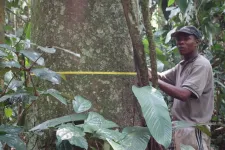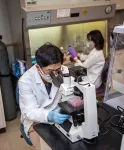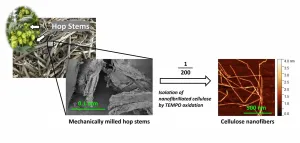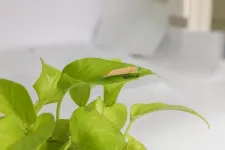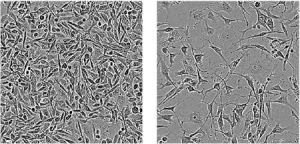INFORMATION:
Further information
https://doi.org/10.1016/j.biocon.2020.108849
For image and video requests, or to arrange interviews, please contact Ian Rosser in the University of Leeds press office i.rosser@leeds.ac.uk
Global network transforming tropical forest research
2021-07-02
(Press-News.org) A huge global network of researchers is working together to take the pulse of our global tropical forests.
ForestPlots.net, which is co-ordinated from the University of Leeds, brings together more than 2,500 scientists who have examined millions of trees to explore the effect of climate change on forests and biodiversity.
A new research paper published in Biological Conservation explains the origins of the network, and how the power of collaboration is transforming forest research in Africa, South America and Asia.
The paper includes 551 researchers and outlines 25 years of discovery in the carbon, biodiversity and dynamics of tropical forests.
Professor Oliver Phillips, of Leeds' School of Geography, said "Our new paper shows how we are linking students, botanists, foresters and policy-makers with the ForestPlots.net technology developed at Leeds.
"This drives a new model of collective research. This is helping to transform scientific understanding of how tropical forests work - and how they are helping to slow climate change.
"In this new synthesis we outline how this collaboration has been built, and trace the exciting potential of collaborative science that reaches across the world's tropical forests to embrace colleagues from all countries and backgrounds."
ForestPlots.net provides a unique place to measure, monitor, and understand the world's forests, and especially the tropical forests.
Established in 2009, it has grown fast to track 5,138 plots in 59 countries, with a network of 2,512 people.
The collaboration, funded by UK NERC and the Royal Society, aims to promote cooperation across countries and continents, and enable partners to access, analyse and manage the information from their long-term plots.
Professor Phillips said: "Our core approach links long-term, grassroots researchers to generate robust large-scale results.
"This global, diverse community is measuring thousands of forests tree-by-tree in long-term plots.
"By connecting tropical researchers together and valuing the key role of the data originator in scientific discovery, our Social Research Network model of research seeks to support the key workers who make 21st century big data science possible."
ForestPlots.net hosts data from many individual researchers and networks including AfriTRON, ECOFOR, PPBio, RAINFOR, TROBIT and T-FORCES.
Working together equitably, the network has shown that long-term monitoring of forests on-the-ground is irreplaceable, making scientific discoveries across the globe.
Through large scale analysis, ForestPlots.net researchers discover where and why forest carbon and biodiversity respond to climate change, and how they help control it with a billion tonne annual carbon sink.
The new research paper, Taking the pulse of Earth's tropical forests using networks of highly distributed plots, provides a vision for more integrated and equitable monitoring of Earth's most precious ecosystems.
The collaborative paper is particularly timely as it also highlights the impact Leeds and research partners have made to the understanding of carbon dynamics in tropical forests ahead of the global climate conference COP26, which takes place in Glasgow in November.
ELSE PRESS RELEASES FROM THIS DATE:
Kansas State University virologists publish new findings on SARS-CoV-2 treatment option
2021-07-02
MANHATTAN, KANSAS -- A recent study by Kansas State University virologists demonstrates successful postinfection treatment for SARS-CoV-2, the virus that causes COVID-19.
College of Veterinary Medicine researchers Yunjeong Kim and Kyeong-Ok "KC" Chang published the study in the prestigious journal Proceedings of the National Academy of Sciences of the United States of America, or PNAS. They found that animal models infected with SARS-CoV-2 and treated with a deuterated protease inhibitor had significantly increased survival and decreased lung viral load.
The results suggest that postinfection treatment with inhibitors of proteases that are essential for viral replication may be an effective treatment against SARS-CoV-2. ...
A globally important microbial process hidden on marine particles
2021-07-02
How on Earth?
It has puzzled scientists for years whether and how bacteria, that live from dissolved organic matter in marine waters, can carry out N2 fixation. It was assumed that the high levels of oxygen combined with the low amount of dissolved organic matter in the marine water column would prevent the anaerobic and energy consuming N2 fixation.
Already in the 1980s it was suggested that aggregates, so-called "marine snow particles", could possibly be suitable sites for N2 fixation, but this was never proven.
Until now..
In a new study, researchers from the University of Copenhagen demonstrate, by use of mathematical models, ...
Only 20 states used health equity committees in COVID-19 vaccine distribution planning
2021-07-02
During the large second wave of the COVID-19 pandemic in fall 2020, pulmonologist and critical care provider Juan C. Rojas, MD, reflected on how disproportionately members of minority populations were being affected by the disease. After hearing similar thoughts from colleagues in New Orleans and New York City, Rojas began to wonder how, if at all, state governments planned to ensure these disparities would be addressed when COVID-19 vaccines were rolled out to the public.
In a new study published July 2 in JAMA Network Open, Rojas and his team were surprised ...
Lottery-based incentives do not increase COVID-19 vaccination rates
2021-07-02
(Boston)--Would you be more willing to get vaccinated against the COVID-19 virus if you could participate in a lottery for cash and prizes? The answer was surprisingly no, according to Boston University School of Medicine (BUSM) researchers who found that Ohio's "Vax-a-Million" lottery-based incentive system, intended to increase COVID-19 vaccination rates, was not associated with an increase in COVD-19 vaccinations.
Prior reports in the media had suggested that the Ohio lottery increased COVID-19 vaccinations, leading other states to use COVID-19 vaccine incentive lotteries in an attempt to increase slowing vaccination rates. "However, prior evaluations of ...
Waste hop stem in the beer industry upcycled into cellulose nanofibers
2021-07-02
Some three quarters of the biomass in hop plants used in beer-making ends up in landfills. But a group of Japanese researchers has developed a technique that 'upcycles' that waste hop into cellulose nanofibers (CNFs). A paper describing the technique was published in the journal ACS Agricultural Science & Technology on June 11.
In the past few years, craft beer-making has exploded in popularity around the world, including many beer styles that make use of many more and different types of hops than conventional commercial beers. A traditional preservative in beer, hops also add ...
Insect-sized robot navigates mazes with the agility of a cheetah
2021-07-02
Berkeley -- Many insects and spiders get their uncanny ability to scurry up walls and walk upside down on ceilings with the help of specialized sticky footpads that allow them to adhere to surfaces in places where no human would dare to go.
Engineers at the University of California, Berkeley, have used the principle behind some of these footpads, called electrostatic adhesion, to create an insect-scale robot that can swerve and pivot with the agility of a cheetah, giving it the ability to traverse complex terrain and quickly avoid unexpected obstacles.
The robot is constructed from a thin, layered material that bends and contracts when an electric voltage is applied. In a 2019 paper, the research team demonstrated that this simple ...
Solving a long-standing mystery about the desert's rock art canvas
2021-07-02
Wander around a desert most anywhere in the world, and eventually you'll notice dark-stained rocks, especially where the sun shines most brightly and water trickles down or dew gathers. In some spots, if you're lucky, you might stumble upon ancient art - petroglyphs - carved into the stain. For years, however, researchers have understood more about the petroglyphs than the mysterious dark stain, called rock varnish, in which they were drawn.
In particular, science has yet to come to a conclusion about where rock varnish, which is unusually rich in manganese, comes from.
Now, scientists at the California Institute of Technology, the Department of Energy's SLAC National Accelerator ...
UMass Amherst research pinpoints role of dopamine in songbird's brain plasticity
2021-07-02
Neuroscientists at the University of Massachusetts Amherst have demonstrated in new research that dopamine plays a key role in how songbirds learn complex new sounds.
Published in the Journal of Neuroscience, the finding that dopamine drives plasticity in the auditory pallium of zebra finches lays new groundwork for advancing the understanding of the functions of this neurotransmitter in an area of the brain that encodes complex stimuli.
"People associate dopamine with reward and pleasure," says lead author Matheus Macedo-Lima, who performed the research in the lab of senior author Luke Remage-Healey as a Ph.D. student in UMass Amherst's Neuroscience and Behavior graduate program. "It's a very well-known concept that dopamine is involved in learning. ...
Potential drug target for difficult-to-treat breast cancer: RNA-binding proteins
2021-07-02
In cancer research, it's a common goal to find something about cancer cells -- some sort of molecule -- that drives their ability to survive, and determine if that molecule could be inhibited with a drug, halting tumor growth. Even better: The molecule isn't present in healthy cells, so they remain untouched by the new therapy.
Plenty of progress has been made in this approach, known as molecular targeted cancer therapy. Some current cancer therapeutics inhibit enzymes that become overactive, allowing cells to proliferate, spread and survive beyond ...
Evaluation of health equity in COVID-19 vaccine distribution plans in US
2021-07-02
What The Study Did: Researchers in this study aimed to determine how each state and the District of Columbia planned to ensure equitable COVID-19 vaccine distribution.
Authors: Juan C. Rojas, M.D., of the University of Chicago, is the corresponding author.
To access the embargoed study: Visit our For The Media website at this link https://media.jamanetwork.com/
(doi:10.1001/jamanetworkopen.2021.15653)
Editor's Note: The article includes conflict of interest and funding/support disclosures. Please see the article for additional information, including other authors, author contributions and affiliations, conflict of interest and financial ...
